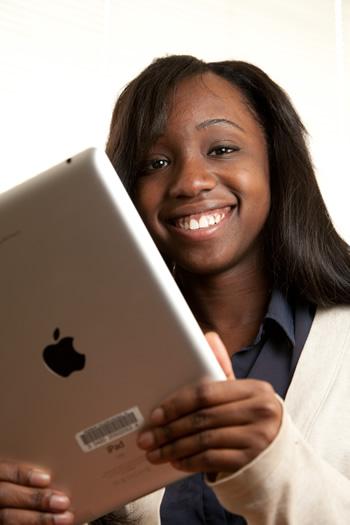iPad Pilot Puts Power in Students' Hands
Student Story

Author Fabiola Cineas ’12 also participated in the iPad pilot. “I was a little shocked to see the range in opinions about the usefulness of the iPad,” she says. “Yet we all agree that the iPad can be useful in the classroom once apps become more versatile and specific to various academic disciplines.”
By Fabiola Cineas '12
The classroom of the future may have come to us sooner than we anticipated. At the start of the fall 2011 semester, students in two classes—Associate Professor of English Carol Ann Johnston’s Renaissance Lyric and Assistant Professor of Italian James McMenamin’s Dante’s Divine Comedy—received iPads, at no cost.
“Our job is to throw things out there and see what the utility is in the classroom,” says Patricia Pehlman, director of Instructional & Media Services. Pehlman decided to try an iPad pilot program at Dickinson after attending the Educause Learning Initiative Conference. There she learned about other colleges in similar programs and Apple’s 1 to 1 Learning program, which allows schools to provide various forms of mobile technology to all of their students.
“We had the funds to buy 24 iPads, and we had to just jump in and do it,” she says. “The iPad fills a strange niche between your personal computer and mobile cellular device. With this pilot program we’re trying to identify what problems the iPad may solve.”
The aim of the pilot is to “explore students’ ability to have immediate, searchable access to all their course materials in one lightweight device and to navigate them quickly and easily,” adds Ryan Burke, Web programmer. “We also want to explore the impact of iPad-based course materials on comprehension and classroom discussion and whether iPads can contribute to a significant reduction in the use of paper.”
Pehlman set out to find two classes in which faculty members were not using any significant technology or working in “smart” classrooms. After reviewing the list of fall courses, Pehlman chose Johnston and McMenamin because, although they weren’t using mobile technology in the classroom, both were familiar with it—Johnston had an iPod Touch and McMenamin had an iPhone.
Johnston was excited about integrating the iPad into her 300-level English course on Renaissance poetry. Before introducing it to her students, she looked for apps that she could seamlessly incorporate into lessons.
“I was very concerned about having a no-cost experience for the students,” she explains.
“I spent time researching apps that would allow them to open PDFs, annotate, underline, highlight, save and copy—all for free.”
For example, “eClicker on the iPad allowed me to have my students answer multiple-choice questions about the reading material as soon as they came into class,” Johnston continues. “The app would immediately tell me how many students got which questions wrong, and from that I would know exactly what we needed to review in class.”
Students also experimented with Evernote, iAnnotate and Dropbox. “With Evernote my students were able to take notes and sync them across a wide variety of platforms,” explains Johnston. “iAnnotate was essential to marking up PDFs. Dropbox allowed my students to manage their files.”
Johnston’s assessment? “The iPad would be indispensable if we could design our own apps, because we could create exactly what we needed. Everything just needs to catch up,” she says.
McMenamin took a different approach. “I didn’t want students to feel that this experiment was an extra burden on them,” he explains. “Therefore, I didn’t require my students to bring the iPad to class every day, nor did I require them to download various apps and programs. I wanted them to feel naturally compelled to use the iPad. As a result, some students used the iPad religiously even in class, while others used it only at home. There were even one or two who didn’t remove it from the box.”
Art & art history major Danielle Kelly ’12 fell in love with her iPad from the beginning. “I was excited because I had never used one before,” she explains, adding that she used it extensively for her reading assignments and to-do lists.
McMenamin sees the iPad having a specific, limited use—such as an electronic textbook, for example. “If this technology allows students to multitask in the classroom—read e-mail, check Facebook, chat with friends and order stuff on Amazon—it will be a hindrance,” he says. “And this is coming from someone who loves technology.”
Pehlman is continuing the pilot through the spring semester. Although the idea of providing an iPad for every student is a long way down the road, the devices “are valuable because we put power into the hands of the students,” she says. “We’re interested in seeing what happens when students explore and find things in their own way. We’re interested in seeing how students can discover and share.”
Published April 3, 2012